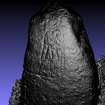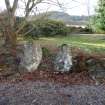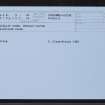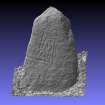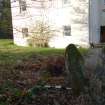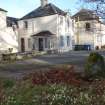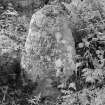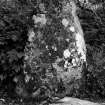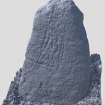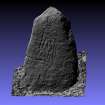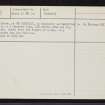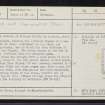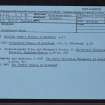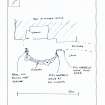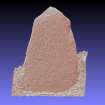Moniack Castle Balblair Stone
Cup Marked Stone (Neolithic) - (Bronze Age), Pictish Symbol Stone (Pictish)
Site Name Moniack Castle Balblair Stone
Classification Cup Marked Stone (Neolithic) - (Bronze Age), Pictish Symbol Stone (Pictish)
Alternative Name(s) Balblair Stone; Wester Balblair; Moniak Castle Wineries; Moniack Castle Wineries
Canmore ID 12732
Site Number NH54SE 9
NGR NH 55172 43583
NGR Description Removed from NH c. 509 451
Datum OSGB36 - NGR
Permalink http://canmore.org.uk/site/12732
- Council Highland
- Parish Kirkhill
- Former Region Highland
- Former District Inverness
- Former County Inverness-shire
Field Visit (21 December 1964)
This stone, at NH 5518 4357, is basically as described by Jolly, it is 1.3metres high, 0.8 metres wide and 0.3 metres thick. Apart from the figure of a man, only three cup marks are now visible.
Surveyed at 1/2500.
Visited by OS (R D) 21 December 1964
Field Visit (April 1979)
Balblair Stone NH 509 451 NH54NW
This boulder, which stands 1.22m high, bears an incised human figure. When first recorded the stone stood about 92m W of the former parish school, but it was removed to Moniack Castle (NH 551 435) before 1881. Nothing can now be seen of the supposed cup-marks noted by Jolly, and the outline of the figure shows considerable signs of wear.
RCAHMS 1979, visited April 1979
Stuart 1856-67, ii, 72; Jolly 1882, 340-1; OS Record Card NH 54 SE 9
External Reference (9 March 2007)
Scheduled as 'Balbalir Stone, symbol stone, Moniak [Moniack] Castle Wineries... an earthfast, upright carved stone bearing abstract and figurative carving which is prehistoric and early medieval in date'.
The stone is 1.3m high, 0.8m wide and 0.3m thick, and displays the Pictish carving of a man apparently walking from left to right holding a staff or sword, as well as prehistoric cupmarks. It is situated within a modern garden rockery immediately SW of Moniak [Moniack] Castle.
Information from Historic Scotland, scheduling document dated 9 March 2007.
Note (6 February 2020)
Date Fieldwork Started: 06/02/2020
Compiled by: NOSAS
Location Notes: The panel stands in the W end of the rockery immediately outside the entrance to Moniack Castle, where it has been moved from its original location. Canmore has two records for this panel: the other one, which has been recorded as a duplicate is BALBLAIR (Canmore ID 269922, SCRAP ID 2676).
Panel Notes: The panel is a smoothly rounded boulder of schist measuring, above ground, 1.2m high x 0.8m broad x 0.3m thick, standing upright. It was not cleaned other than to remove some leaves from around the base, although it is covered in moss and lichen. The lower part of the carving of a man was faintly visible. Near the base of the stone there is one possible cupmark. There was no other evidence of cupmarks in the moss and lichen covered area, and if there are likely to be very faint. There may be further cupmarks below the current ground surface.
Desk Based Assessment
NH54SE 9 5518 4357 Removed from NH c. 509 451
For original location (NH54NW 155 c. 509 451), see NH54NW 155.
In the rockery at Moniack Castle is a stone, about 4 1/2 ft. in height, bearing the outlined figure of a man with a stick or other instrument in his hand, and fourteen cup-marks, one of which has been mistaken for the eye of the figure. The stone stands at the end of the rockery farthest from the entrance gate. 'This stone was brought from a spot where it stood for a time, close to the old parish school of Kilmorack, near Kilmorack Free Church. It was however, removed to this place between fifty and sixty years ago, from a spot 100 yard further west, when the ground was them reclaimed. There is nothing known of the stone, traditional or otherwise, beyond this.
(These sitings place the original location in the vicinity of Balblair. (NH 50 45))
Information from OS.
W Jolly 1882.
























